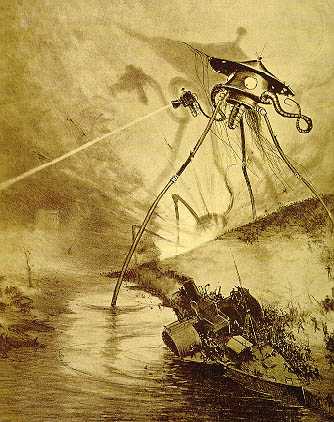Tales of an Invented God
The most important characteristic of an AI cult is that its gods (Godbots?) will be created by the AI developers and not the other way aroundThe cult of AI plus ET (artificial intelligence plus extraterrestrial intelligence), highlighted in philosopher of science Mike Keas’s new book Unbelievable, underlies thousands of articles in the popular science media every year. Two key themes are worth highlighting, one each from AI and ET:
The most important characteristic of an AI cult is that its gods (Godbots?) will be created by the AI developers and not the other way around. They propose to endow their creations with rights. Former Google executive Anthony Levandowski has started a Church of AI, committed to “peaceful transition to the precipice of consciousness.”
From the Church’s online presence:
In “recent” years, we have expanded our concept of rights to both sexes, minority groups and even animals, let’s make sure we find a way for “machines” to get rights too.
Most readers will probably have difficulty thinking of a problem that legal personhood for machines would help solve but surprising numbers of people and governments are working on it or considering it.
Levandowski may be an outlier but, we are told, he reflects a Silicon Valley mindset:
Nobody but Levandowski knows if he really believes he can create a Godbot. Considering his obsession with artificial intelligence, it is altogether possible that he does. And while that may seem nuts, people have started religions for stranger reasons. The Way of the Future could be an elaborate tax scam and this still would not necessarily invalidate its claims to be a religion; people sincerely believe in Scientology, after all. Further, Levandowski’s belief isn’t so strange within the context of Silicon Valley, which has long invested religious hopes in its creations. Sarah Jones, “Silicon Valley’s Religious Drive” at The New Republic
Dan Brown, the famous author of The DaVinci Code, thinks that an AI-based collective consciousness created by global connections will replace God: “Our need for that exterior god, that sits up there and judges us … will diminish and eventually disappear.”
At New Scientist, Sean O’Neil asked, “Could we become gods?” (2015) and cognitive roboticist Murray Shanahan replied, “There’s nothing magical about the brain; it doesn’t transcend physics. So, of course, it is possible to build a physical entity that can do anything we can do.” For the AI culture, that seems to mean yes, we can become godbots.
Commentator Tyler O’Neil sees an inherent contradiction in this drive for “creating a deity of artificial intelligence and then worshipping it.” But technocrat religion seems to aspire to control rather than worship or—at most—it worships entirely on its own terms. The Godbot can be developed or not; likewise, it can be worshipped or not, as the believer wishes.
That’s not an entirely new idea. Nearly three millennia ago, the prophet Isaiah satirized people who used one half of the wood they cut down for firewood and then made an idol for worship out of the other half (44:13-20). That was all pretty low-tech by today’s standards. But then as now, the worshipper was very much in charge of the fate of the deity.
Having created the AI that seems like God, the worshippers expect to become like it, as transhumanist cyborgs. They will then look out on a vast universe where many intelligent aliens are also transcendant cyborgs. Which brings us to the other key element in the AI/ET creed: “They” ARE Out There—no matter what the technophobes and deniers say! And no matter what the data shows.
Recently, some establishment scientists actually saw asteroid Oumuamua as ET, an “extraterrestrial light sail.” The rumor quickly died, but there is not likely to be a shortage of new speculations. They come so fast. Here’s a summary from 2013 of reasons why They Are Out There even though we haven’t found any evidence for Them:
The Perimeter Institute’s Adrian Kent explicitly invokes Darwinian theory to account for the aliens’ absence: Natural selection, he argues, favors quiet aliens, due to competition on a cosmic scale for natural resources. Similarly, Smith dubs his pessimistic view the “misanthropic principle,” a play on the “Anthropic Principle,” meaning that because we are probably alone, we must solve our own problems. As long as he puts it that way, he is mostly safe from charges of being “anti-science.”
At New Scientist (2011), Lee Billings utters the question: “Two decades of searching have failed to turn up another planetary system like ours. Should we be worried?” The magazine editorialized an answer pronto:
“The fact that there are few plausible Earth lookalikes among the 1200-plus candidate planets identified by Kepler is not hard to explain away. Such small lumps of rock are more elusive than bigger gassy bodies, and once they have been glimpsed it will take time to verify their existence. More perplexing is the apparent lack of any other solar systems that have the familiar qualities of our own, which we believe to have given rise to life.”
More often we are just told that we lack imagination, we have searched too narrowly: Moonless planets have been unfairly dismissed and sunless ones could maybe ferry life around the galaxy. Some argue that hardy Earth life forms could have made it to one of Jupiter’s moons and survived there. Jupiter’s moon Europa looks promising to many. NASA has talked of a “flying-saucer-shaped space boat” to Saturn’s moon Titan, some day. And the excitable word about another Saturn moon is, “Enceladus Now Looks Wet, So It May Be ALIVE!”
Exoplanets orbiting red dwarfs at a distance, it is said, may counterintuitively support life. So might exoplanets’ moons. Every month, we hear of a planet or moon capable of supporting hype.
More exotically, some seek life around failed or dying stars. If that doesn’t work, dark matter could make planets habitable (though we don’t yet know what dark matter is). And, should the laws of physics vary from place to place, life elsewhere might follow different laws. In that case, should the physics term “constant” be changed to “local variant”?
Lastly, encountering hard, doubting hearts, alien life proponents resort to moralizing: An editorial preaches “Uniqueness seems rather too presumptuous a claim for one small planet in an undistinguished corner of a vast cosmos.” Our vaunted respect for evidence is a mere cloak for pride and presumption! Denyse O’Leary, “How Do We Grapple with the Idea that ET Might Not Be Out There?” at Evolution News and Science Today:
The Search for Extraterrestrial Intelligence (SETI) always finds culturally creative ways to keep looking. When all else fails, try Bayesianism.
Unless, of course, the sin of climate change killed all the ETs. Remember, these created gods can sin. And die.
Oxford researchers recently published a paper arguing that they had dissolved the Fermi Paradox! (that is, the researchers think They Are Not Out There). SETI, as always, presses on regardless.

Alien tripod by Alvim Corréa, 1906 French edition of H.G. Wells’ “War of the Worlds”
The good news for AI/ET is, no one can ever prove conclusively that They’re Not Out There. As long as there’s an Out There, They’ll always be Out There. And the popular science media will report breathlessly on all their latest non-doings.
If that’s the good news, here is the bad news: AI/ET’s most advanced gods, if they exist, may not be pleased with us. Harvard’s chair of astronomy (of “extraterrestrial light sail” fame) said recently:
If life was seeded artificially on Earth, one may wonder whether the seeders are checking on the outcome. And if so, the fact that we have not heard from them may indicate that they are disappointed. The experiment may have failed, or we are simply too slow to mature. Well, this may not come as a surprise given the irresponsible way we behave sometimes. Perhaps if we only knew that someone is looking over our shoulders, we would do better. It is not too late for us to find out, by using the best telescopes at our disposal. Abraham Loeb, “Advanced Extraterrestrials as an Approximation to God” at Scientific American
A book on the new pop science religion might well be titled “Tales of an Invented God.” Its author would likely be challenged to keep up with all the non-events breathlessly documented. After all, the technocrats who invent their future gods can change, re-envision, replace, upgrade, eliminate them at any time.
That flexibility offers a definite social advantage over traditional monotheism, which insists on God’s actual—as opposed to predicted or imagined— presence. His absolute moral superiority compels the grumbling believer to behave according to traditional ethical standards, however cumbersome. Compared to the futurist phantoms of the Singularity or ET, such a deity is not only real but, let’s face it, all too real for many.
See also: AI as an emergent religion Science philosopher Mike Keas’s new book discusses how AI and ET are merging, to create a religion of futurist magic
and
Can machines be persons? What would the real effect of legal personhood for machines be?
